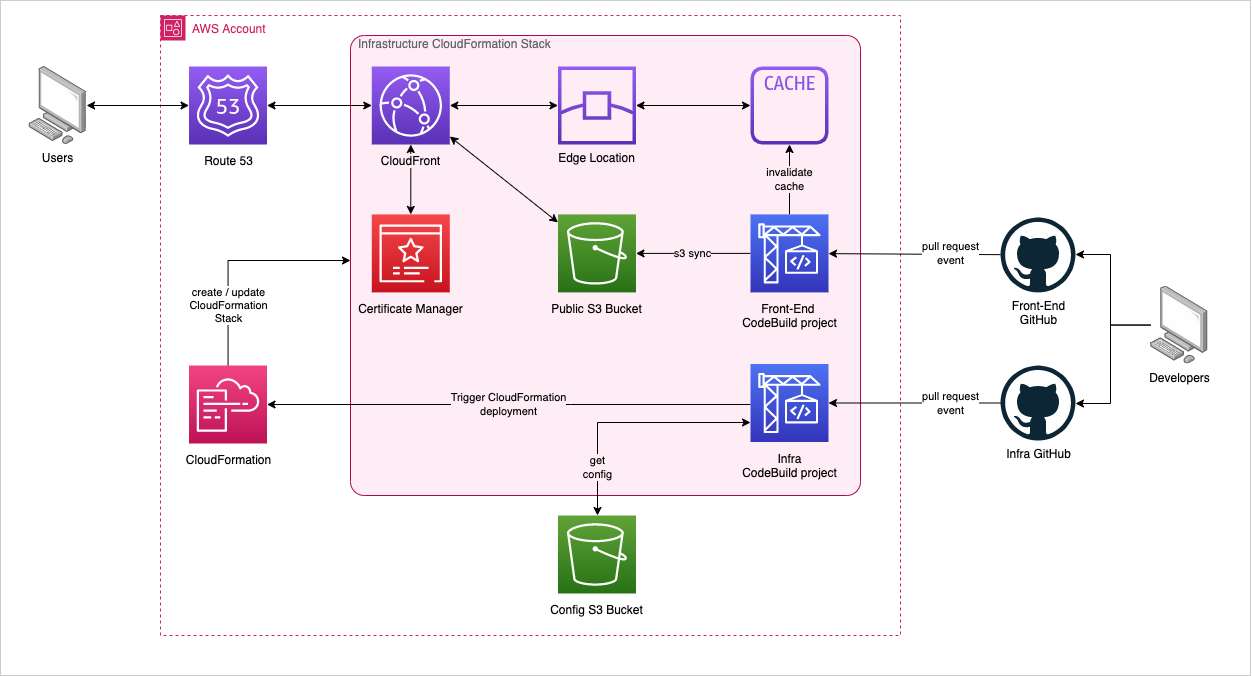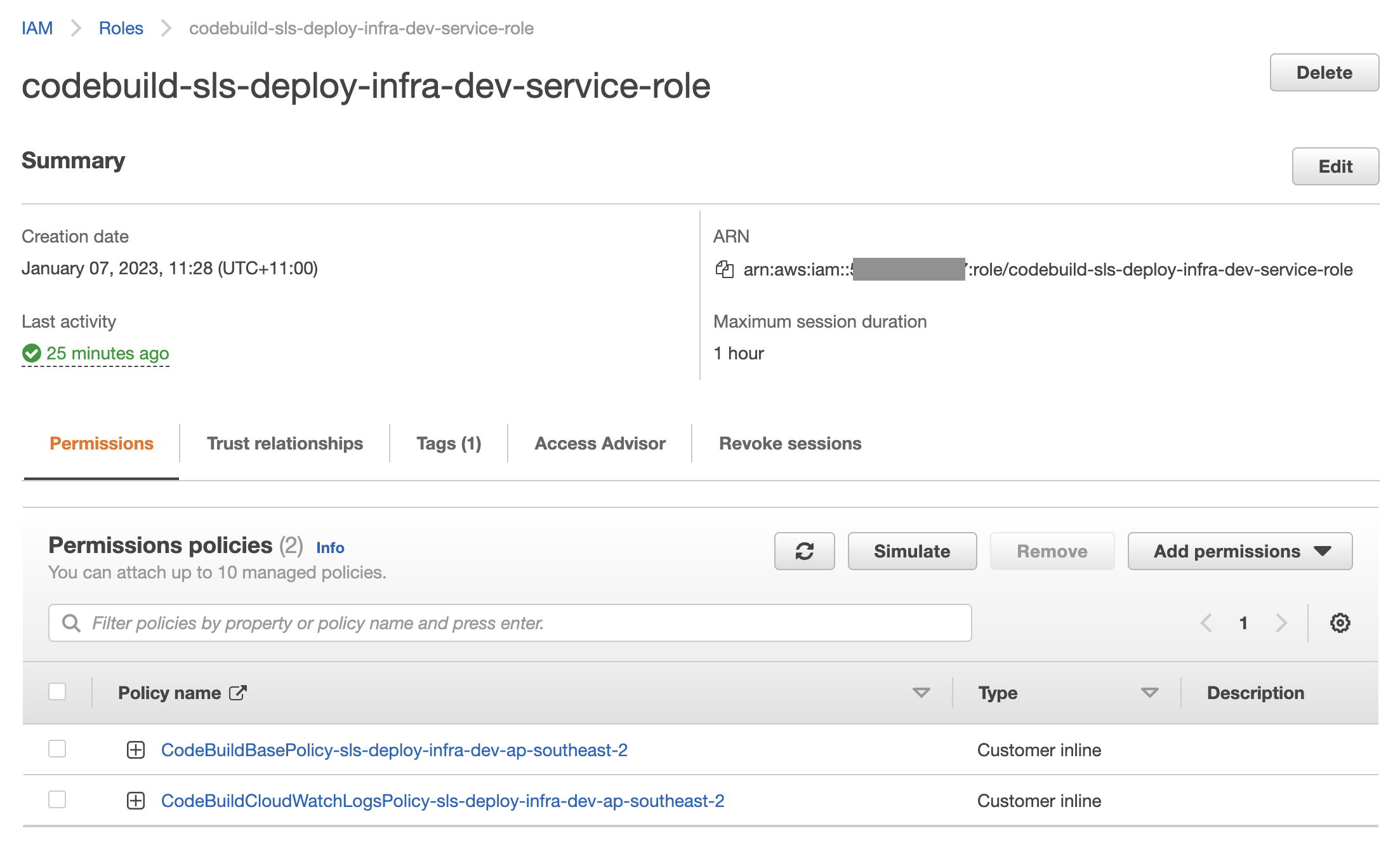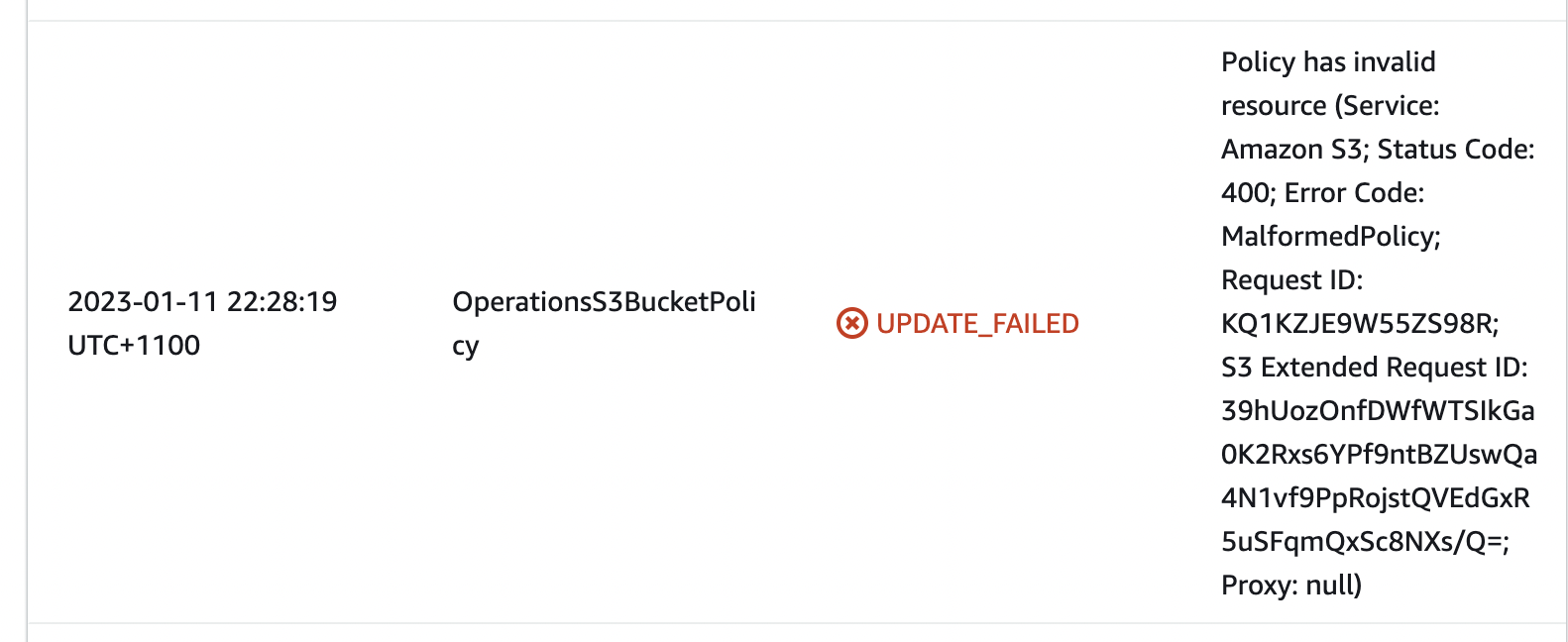- Published on
CI/CD Pipeline for Infrastructure with CodeBuild and Serverless Framework
Part 5 of "Deploy Static Website To AWS"
Table of Contents
- Overview
- The Problem
- The Goal
- The Target Architecture
- Limitations
- Creating the Infrastructure CodeBuild Resources
- Differences Between the Front-End and Infrastructure CodeBuild Projects
- Thoughts on Common Stack
- Create the Common Stack
- Deploy stack
- Create the Infrastructure Build Script
- Create the CodeBuild Project
- Deploy Steps
- Update the Buildspec
- Merge Code to Deploy
- [Troubleshooting] MalformedPolicy:
- What's Next
Overview
The Problem
Part 3 in this series, which focused on creating and managing resources via a template, had significantly reduced the complexity surrounding creating and managing different resources for environments and projects. With little setup, developers can quickly deploy the infrastructure and pipeline for front-end deployment, however the infrastructure deployment still needs to be kicked off and managed manually.
This manual deployment and management has the some drawbacks:
- Developers need to actively deploy each time code is committed which requires direct access via the AWS CLI
- Deployed versions can differ from the repo
- Can deploy from any branch
- Can deploy uncommitted code
- Developers can accidentally deploy to the wrong environment
- And so on
The Goal
Similar to the pipeline created in part 4 for the front-end, the infrastructure should have it's own deployment pipeline which is triggered certain changes to the GitHub repo.
The Target Architecture
By the end of this post, the front-end and infrastructure will each have its own pipeline for each environment. Any merges from the GitHub repo into the target release branch will trigger the respective deployment for the target environment. 
Limitations
The biggest downside of this approach is the amount of CodeBuild projects (ie pipelines) being created. This approach leads to a CodeBuild project for each and every deployed environment. In the series we have been targeting a development and a production environment which means a minimum of 4 pipelines. As of writing, CodeBuild costs $1 per active pipeline plus the usage on the pipeline. CodeBuild doesn't charge for any pipelines within the first 30 days of their creation to promote experimentation, but this is a substantial cost for our infrastructure. In a future post, we will explore reducing the amount of pipelines in a multi-environment landscape.
Creating the Infrastructure CodeBuild Resources
Differences Between the Front-End and Infrastructure CodeBuild Projects
Following on from part 4, and duplicating the front-end CodeBuild resources, there are only a few updates/considerations in order to get the new pipeline working:
- Config file
- Currently not being pushed to GitHub, lets keep it that way
- Opt to house the config file in an S3 bucket
- Create a common Stack, which includes:
- A common S3 bucket for the config file
- Allow all environments to use the common configuration
- In the future we will use this to house the blog posts allowing the separation between the blog posts and the Front-End changes
- Duplicate existing code pipeline
.ymlfile- Import the new infrastructure resources into the
serverless.ymlfile
- Import the new infrastructure resources into the
- New buildspec to deploy infrastructure
- Update Resource identifiers and names to differentiate between Infra and FE resources
- Update the references to the Infra resources
- Remove unnecessary IAM permissions in the policy documents
- No need to copy anything to the static files bucket
- No need to invalidate any cache
Thoughts on Common Stack
- We store one config object which contains the config for all environments, it may be better to create a separate config file for each env
- We will store the config as a document in S3. It is secure enough for our purposes
- We are not storing any passwords or anything sensitive
- Create a new 'operations' bucket for the config, it may seem like overkill but we will use this of more later
- Don't want to use the WebApp bucket as this is only for public content
- We could use the deployment bucket, but I like keeping the deployment bucket only for deployments and as more of a throwaway
- Set the bucket deletion policy to keep
- Deploy the bucket first to create the config bucket and file, then update the buildspec to copy the config from S3 into the local env
- In this example the policy document is set to allow all get operations from s3... this could probably be more restrictive
Create the Common Stack
Create new repo outside of your infrastructure and front-end repos:mkdir common-resources
Add below serverless.yml to create common S3 bucket and policy
# serverless.yml
service: sls-deploy-common # overwrites the stack name to remove the stage
frameworkVersion: '3'
provider:
name: aws
runtime: python3.8
stackName: sls-deploy-common
custom:
commonBucket: sls-deploy-common
resources:
Resources:
CommonS3Bucket:
Type: AWS::S3::Bucket
Properties:
BucketName: ${self:custom.commonBucket}
AccessControl: Private
CommonS3BucketPolicy:
Type: AWS::S3::BucketPolicy
Properties:
Bucket:
Ref: CommonS3Bucket
PolicyDocument:
Statement:
- Sid: AllowCloudFormationGetAccess
Effect: Allow
Principal:
Service: 'cloudformation.amazonaws.com'
Action:
- s3:GetObject
- s3:ListBucket
Resource:
- arn:aws:s3:::${self:custom.commonBucket}
- arn:aws:s3:::${self:custom.commonBucket}/*
Deploy stack
Note: no need to specify the environment as we are creating a stack which will be shared by all environmentssls deploy --region ap-southeast-2 --verbose
Copy config from local into bucketaws s3 cp ../infra/.config/env.json s3://sls-deploy-common/config/
Create the Infrastructure Build Script
- Needs to do:
- Copy the config from the common bucket
- Run the deploy command
version: 0.2
phases:
pre_build:
commands:
- echo installing serverless
- npm install -g serverless
post_build:
commands:
- echo copying config file to locally
- mkdir .config
- aws s3 cp s3://sls-deploy-common/config/env.json ./.config/
- echo config copying echo deploying serverless infrastructure
- sls deploy --region ${aws:region} --stage ${self:custom.stage} --verbose
- echo successfully deployed
Format the buildspec
version: 0.2\n\nphases:\n pre_build:\n commands:\n - echo installing serverless\n - npm install -g serverless\n post_build:\n commands:\n - echo copying config file to locally\n - mkdir .config\n - aws s3 cp s3://sls-deploy-common/config/env.json ./.config/\n - echo config copying echo deploying serverless infrastructure\n - sls deploy --region ${aws:region} --stage ${self:custom.stage} --verbose\n - echo successfully deployed
Create the CodeBuild Project
Similar to the front-end CodeBuild project, create the pipeline to deploy the infrastructure resources
# resources/infrastructure-codebuild-resources.yml`
Resources:
InfraBuildPipelineCodeBuildBasePolicy:
Type: AWS::IAM::Policy
Properties:
PolicyName: CodeBuildBasePolicy-sls-deploy-infra-${self:custom.stage}-${aws:region}
Roles:
- !Ref InfraBuildPipelineServiceRole
PolicyDocument:
Version: '2012-10-17'
Statement:
- Effect: Allow
Action:
- logs:*
Resource:
- arn:aws:logs:${aws:region}:${aws:accountId}:log-group:/sls-deploy-${self:custom.stage}-infra
- arn:aws:logs:${aws:region}:${aws:accountId}:log-group:/sls-deploy-${self:custom.stage}-infra/:*
- Effect: Allow
Action:
- s3:GetBucketAcl
- s3:PutObject
- s3:GetObject
- s3:GetBucketLocation
- s3:GetObjectVersion
Resource:
- arn:aws:s3:::codepipeline-${aws:region}-*
- Effect: Allow
Action:
- s3:GetObject
- s3:ListBucket
Resource:
- arn:aws:s3:::${self:custom.commonBucket}
- arn:aws:s3:::${self:custom.commonBucket}/*
- Effect: Allow
Action:
- cloudformation:*
Resource:
- arn:aws:cloudformation:${aws:region}:${aws:accountId}:stack/${self:custom.stackName}
- arn:aws:cloudformation:${aws:region}:${aws:accountId}:stack/${self:custom.stackName}/*
- Effect: Allow
Action: cloudformation:ValidateTemplate
Resource: '*'
- Effect: Allow
Action: s3:*
Resource:
- Fn::Join:
- ''
- - 'arn:aws:s3:::'
- Ref: ServerlessDeploymentBucket
- Fn::Join:
- ''
- - 'arn:aws:s3:::'
- Ref: ServerlessDeploymentBucket
- '/*'
InfraBuildPipelineCodeBuildCloudWatchLogsPolicy:
Type: AWS::IAM::Policy
Properties:
PolicyName: CodeBuildCloudWatchLogsPolicy-sls-deploy-infra-${self:custom.stage}-${aws:region}
Roles:
- !Ref InfraBuildPipelineServiceRole
PolicyDocument:
Version: '2012-10-17'
Statement:
- Effect: Allow
Action:
- logs:CreateLogGroup
- logs:CreateLogStream
- logs:PutLogEvents
Resource:
- arn:aws:logs:${aws:region}:${aws:accountId}:log-group:slsdeploy.com-infra/
- arn:aws:logs:${aws:region}:${aws:accountId}:log-group:slsdeploy.com-infra/:*
InfraBuildPipelineServiceRole:
Type: AWS::IAM::Role
Properties:
RoleName: codebuild-sls-deploy-infra-${self:custom.stage}-service-role
AssumeRolePolicyDocument:
Version: '2012-10-17'
Statement:
- Effect: Allow
Principal:
Service:
- codebuild.amazonaws.com
Action: sts:AssumeRole
Policies:
- PolicyName: InfraBuildPipelinesIAMPermissionsPolicy-sls-deploy-infra-${self:custom.stage}-${aws:region}
PolicyDocument:
Statement:
- Effect: Allow
Action:
- iam:Get*
- iam:List*
- iam:PassRole
- iam:CreateRole
- iam:DeleteRole
- iam:AttachRolePolicy
- iam:DeleteRolePolicy
- iam:PutRolePolicy
- iam:TagRole
- iam:UntagRole
Resource: arn:aws:iam::${aws:accountId}:role/codebuild-sls-deploy-infra-${self:custom.stage}-service-role
- PolicyName: InfraBuildPipelinesCodeBuildPermissionsPolicy-sls-deploy-infra-${self:custom.stage}-${aws:region}
PolicyDocument:
Statement:
- Effect: Allow
Action:
- codebuild:*
Resource:
- arn:aws:codebuild:${aws:region}:${aws:accountId}:report-group/sls-deploy-infra-${self:custom.stage}-*
InfraCodeBuildProject:
Type: AWS::CodeBuild::Project
Properties:
Name: sls-deploy-infra-${self:custom.stage}
Description: Builds the slsdeploy infrastructure for the ${self:custom.stage} environment
ConcurrentBuildLimit: 1
Environment:
ComputeType: BUILD_GENERAL1_SMALL
Image: aws/codebuild/standard:6.0
Type: LINUX_CONTAINER
LogsConfig:
CloudWatchLogs:
GroupName: slsdeploy.com-infra/
Status: ENABLED
StreamName: ${self:custom.stage}
ServiceRole: !Ref InfraBuildPipelineServiceRole
Source:
BuildSpec: "version: 0.2\n\nphases:\n pre_build:\n commands:\n - echo installing serverless\n - npm install -g serverless\n post_build:\n commands:\n - echo copying config file to locally\n - mkdir .config\n - aws s3 cp s3://${self:custom.commonBucket}/config/env.json ./.config/\n - echo config copying echo deploying serverless infrastructure\n - sls deploy --region ${aws:region} --stage ${self:custom.stage} --verbose\n - echo successfully deployed"
GitCloneDepth: 1
Location: https://github.com/daganherceg/sls-deploy-infra.git
Type: GITHUB
SourceVersion: ${self:custom.targetBranch}
Triggers:
Webhook: true
FilterGroups:
- - Type: EVENT
Pattern: PULL_REQUEST_MERGED
- Type: BASE_REF
Pattern: ${self:custom.targetBranch}
Visibility: PRIVATE
Artifacts:
Type: NO_ARTIFACTS
Deploy Steps
A bit of a chicken and an egg situation: in order for the CodeBuild pipeline to kick of the deployment and update the CloudFormation stack, the IAM permissions defined above need to be applied to the existing service role. Either update the IAM manually in the AWS Console or kick off a deployment from the command line as normal.
Another approach to this would be creating the IAM role manually or within the common resources stack and referencing it in the serverless template.

Update the Buildspec
It may be necessary to also update the buildspec manually in the CodeBuild console. I have noticed that in some instances CodeBuild uses the existing spec in the pipeline and have needed to update this manually. More investigation is required to determine the causes and a more stable way of updating the buildspec when required.

Merge Code to Deploy
Once the IAM is updated, future commits to a feature branch are and merging to release/develop and main in GitHub to kick off build.
[Troubleshooting] MalformedPolicy:
When getting the following error during deployment:
Error:
UPDATE_FAILED: OperationsS3BucketPolicy (AWS::S3::BucketPolicy)
Policy has invalid resource (Service: Amazon S3; Status Code: 400; Error Code: MalformedPolicy; Request ID: REQUEST_ID; S3 Extended Request ID: EXTENDED REQUEST_ID/Q=; Proxy: null)
Generally checking the CloudFormation event log in the CloudFormation Management Console is the first place to check.  However, in this instance, the logs do not provide much more information other than one of the resources is invalid.
However, in this instance, the logs do not provide much more information other than one of the resources is invalid.
Additionally, I generally also check CloudTrail which sometimes has a more meaningful error message. In this instance, not so much:
{
...
"errorMessage": "Policy has invalid resource"
...
}
The source of this error in one case was an incorrectly configured reference to the resources. Accidentally had targetBranch: ${self.custom.env.targetBranch} instead of targetBranch: ${self:custom.env.targetBranch}.
What's Next
The next post focuses on decoupling the front-end deployment depending on the concern. The deployment should either occur when the front-end website is updated or one of the blog posts is updated, deleted, or created. Additionally, we will also look at housing the blog posts in a central location to ensure that the blog articles is the same across all environments.